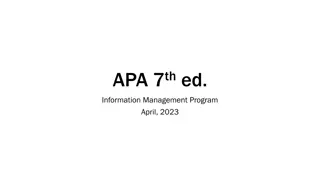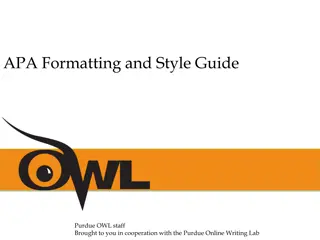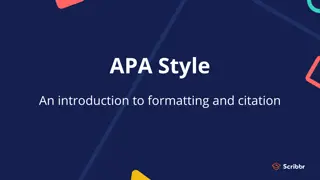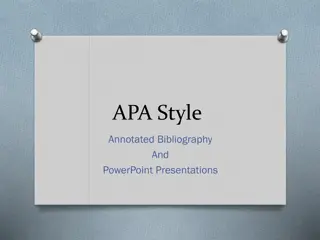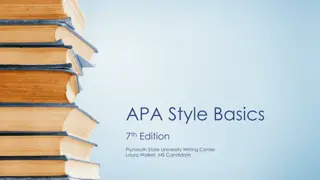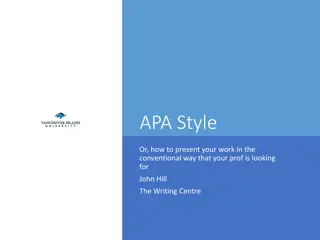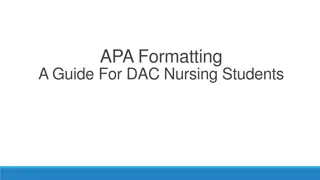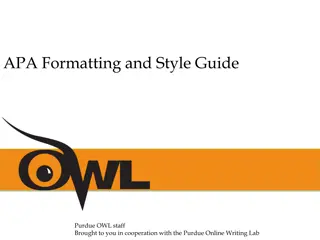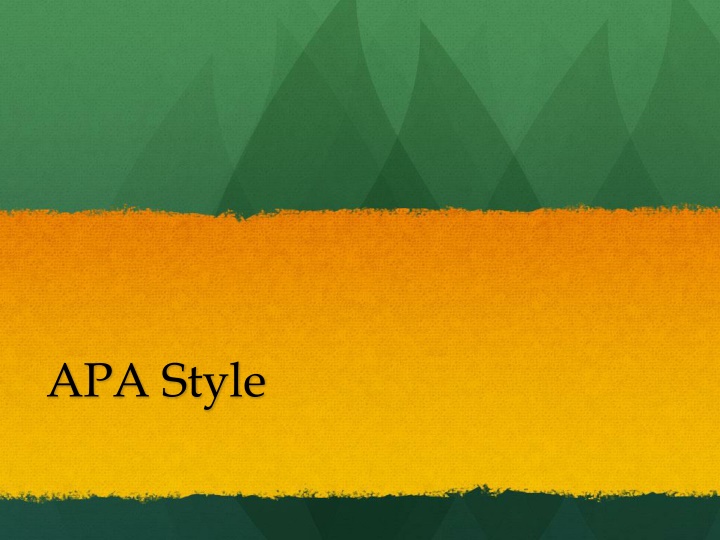
Writing Importance for Human Development and Family Science (HDF)
Discover the significance of writing in HDF, including client advocacy, learning, reflection, and more. Explore various types of documents and the role of APA style in providing guidelines. Learn reasons to cite using APA and how it can enhance your work and credibility.
Download Presentation

Please find below an Image/Link to download the presentation.
The content on the website is provided AS IS for your information and personal use only. It may not be sold, licensed, or shared on other websites without obtaining consent from the author. If you encounter any issues during the download, it is possible that the publisher has removed the file from their server.
You are allowed to download the files provided on this website for personal or commercial use, subject to the condition that they are used lawfully. All files are the property of their respective owners.
The content on the website is provided AS IS for your information and personal use only. It may not be sold, licensed, or shared on other websites without obtaining consent from the author.
E N D
Presentation Transcript
Why is writing important in HDF? Client Advocacy Learning about theories, contexts, other people, and ourselves Reflection and improved practice Sharing knowledge
Types of documents Daily practice: E-mails, letters, newsletters, case records, and reports Professional context: Literature reviews, papers, and presentations Direct advocacy: funding applications, policy proposals, media releases When we write, we reveal who we are.
APA Style Provides Documentation guidelines Expectations for writing style, tone and organization Explicit (thesis up front with map ) Concise Values standardization of papers
APA Writing Guides First Stop: URI library guide http://uri.libguides.co m/hdf Second Stop: Purdue OWL online Third Stop: APA Publication Manual, 6th edition (2010) Fourth Stop: Writing Center
APA Instructional Videos Reference List The Basics http://www.youtube. com/watch?v=HpAOi 8- WUY4&list=PL8F43A6 7F38DE3D5D&index= 2 Word Settings www.youtube.com/pl aylist?list=PL8F43A67 F38DE3D5D&feature= edit_ok http://www.youtube.co m/watch?v=KUjhwGmh DrI
Why cite using APA? Acknowledge & give credit to those you ve learned from Build credibility for yourself and for the people you work with Guide readers to further information I
Why Else? Increase your grade Shows competence Understand what each other mean (we can t all have our own method of citing)
Cover Page Cover page Title (centered, upper of page) Author s name (1 double space below title) Institutional affiliation or course identification (1 double space below author s name)
Title The title of your paper should include 1-2 key concepts and the target population pertaining to your paper topic. For example: The Impacts of Parental Divorce on Young Children is better than . Divorce Impacts
Headings Provide an outline of your paper Use levels consecutively, always start with 1 then 2, and work up. Level of Heading Formatting of Heading 1 Centered, Boldface, Uppercase and Lowercase Heading 2 Flush Left, Boldface, Uppercase and Lowercase Heading 3 Indented, boldface, lowercase paragraph heading ending with a period. 4 Indented, boldface, italicized, lowercase paragraph heading ending with a period. Indented, italicized, lowercase paragraph heading ending with a period. 5
Other Key Things Double-spaced (everything! Even the References) 1 margins on all sides 12 pt. Times New Roman font or clear font that is highly readable Page numbers in upper right corner
In-text citation: When paraphrasing If you mention the author in the sentence, place the publication year in parentheses directly after name: Walter (2000) found that the strengths perspective worked well with If you do not mention the author s name in the sentence, save parenthetical reference for the end & put in alphabetical order if the statement applies to more than one resource. Quality of life domains for older adults, include health status, personality, and personal autonomy (Bond & Corner, 2004) Many researchers have studied the strengths perspective (Davis, 1998; Walter, 2000). Do not write out the title of the journal or the journal name This information is available in the References list.
Reference List Alphabetized by author last name Not numbered Different formats for Journal/scholarly articles Books Chapters in edited volumes Websites Print sources on the web
Journal Article Reference Author, A. A., Author, B. B., & Author, C. C. (Year). Title of article in lower case letters unless word is a Proper Noun or after a sub- title: Like this. Title of Periodical, volume number(issue number), first page # - last page #.
For Example: Moylan, C.A., Herrenkohl, T.I., Sousa, C., Tajima, E.A., Herrenkohl, R.C. & Russo, M.J. (2010). The effects of child abuse and exposure to domestic violence on adolescent internalizing and externalizing behavior problems. Journal of Family Violence, 25(1), 53-63.
Book Reference Author, A. A. (Year of publication). Title of work: Capital letter also for subtitle. City, State: Publisher. * Government reports should look similar to this, listing the author(s) if listed or the government agency as the author.
But when its more complicated?? Author, A. A., & Author, B. B. (Year of publication). Title of chapter. In A. A. Editor & B. B. Editor (Eds.), Title of book (pages of chapter). Location: Publisher. (E. Robbins, personal communication, January 4, 2001). Author, A. A. (Year, Month Day). Title of article. Title of http://www.someaddress.com/full/ Newspaper. Retrieved from
Acronyms All acronyms need to be specified prior to the first use. According to the American Psychological Association (APA), abbreviations are best used only when they allow for clear communication with the audience. 1-2 acronyms per paper is good More = too confusing None = perhaps less sophisticated
Short quotes YOU MUST INCLUDE: Author name, year, quote and page numbers. According to Jones (1998), "Students often had difficulty using APA style, especially when it was their first time" (p. 199).
Long Quotes Place direct quotations that are 40 words, or longer, in a free-standing block of typewritten lines, and omit quotation marks. Maintain double-spacing throughout. The parenthetical citation should come after the closing punctuation mark. Jones's (1998) study found the following: Students often had difficulty using APA style, especially when it was their first time citing sources. This difficulty could be attributed to the fact that many students failed to purchase a style manual or to ask their teacher for help. (p. 199)
In-text citation: When using a direct quote Author in sentence: Miele (1993) found that the placebo effect disappeared when only the first group s behaviors were modified (p. 276). Author not in sentence: She stated that The placebo effect disappeared when behaviors were studied in this manner (Miele, 1993, p. 276).
Use of et al. for in-text citations A Work by Three to Five Authors: List all the authors in the signal phrase (first citation) or in parentheses the first time you cite the source. (Kernis, Cornell, Sun, Berry, & Harlow, 1993) In subsequent citations, only use the first author's last name followed by "et al." in the signal phrase or in parentheses. (Kernis et al., 1993) **** In et al., et should not be followed by a period.
Question about Author? 1st choice: Author Name 2nd choice: Organization as Author American Psychological Association. (2003). 3rd choice: Unknown Author Merriam-Webster's collegiate dictionary (10th ed.).(1993). Springfield, MA: Merriam-Webster. NOTE: When your essay includes parenthetical citations of sources with no author named, use a shortened version of the source's title instead of an author's name. Use quotation marks and italics as appropriate. For example, parenthetical citations of the source above would appear as follows: (Merriam-Webster's, 1993).
I found something that doesn t match up. Please note: While the APA manual provides many examples of how to cite common types of sources, it does not provide rules on how to cite all types of sources. Therefore, if you have a source that APA does not include, APA suggests that you find the example that is most similar to your source and use that format. AKA: Be consistent & importantly do your best!!
Avoiding bias in language (AKA, client-centered language) Be descriptive and specific: Describe individuals and groups as they describe themselves. Find alternatives to the generic he and man. Age: be specific and avoid pejorative terms (e.g. elderly) Person-first language: person with neurosis person who lives with bipolar disorder Racial & ethnic groups are capitalized Black rather than black; White rather than white etc. Sexual orientation rather than sexual preference Sex is biological; gender is social.
Verb Usage - Language Use past tense in literature review and to present your results: Sanchez (2004) reported that We found that 65% of the participants adopted more formal speech Use present tense to discuss or synthesize: Overall analysis suggests that The majority of researchers seem to support the hypothesis
Verb Usage - Language Passive and active voice Verbs are vigorous, direct communicators! Prefer the active voice The survey was conducted in a controlled setting. (passive) We conducted the survey in a controlled setting. (active) Use passive voice judiciously to focus the object or recipient of action rather than the actor The speakers were attached to either side of the chair.
Numbers: Expressed as # s Numbers 10 and above Numbers below 10 grouped for comparison with numbers 10 and above Numbers preceding a unit of measurement or statistical function, such as 25.6%. Numbers representing time, date, age, population size, etc. Numbers in series, such as Table 1, Chapter 7, etc.
Numbers: Expressed as words Numbers below 10 Zero and one when words would be easier to comprehend than numerals Any number that begins a title, text heading, or sentence Common fractions (two-thirds) Numbers expressing approximate lengths of time (about three hours)
Punctuation Use commas between all elements of a series: A, B, and C. Use comma to set off the year in dates and in parenthetical reference citations, as in (Thompson, 2009). Use a semicolon to separate elements in a series already containing commas, as in (Thompson, 2009; Zander, 2010)

